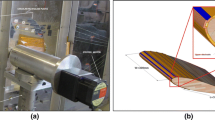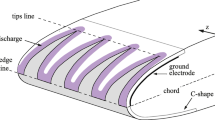Abstract
Bluff body flow control based on plasma actuators requires suitable strategies to attain the desired objectives. The strategy selection becomes more critical in situations where the free airstream velocity is much higher than the maximum velocity that can be produced by the flow control device. In this work, we report recent efforts to produce on a circular cylinder forces in direction transverse to the free flow. Free stream velocities considered in this work are as high as 45 m/s ((Re(O) 1 × 105), which result much higher values than the maximum velocities (about 5 m/s) usually induced by the kind of plasma actuator here considered (dielectric barrier type). Our strategy consisted on promoting asymmetries on boundary layer separation with a four electrode arrangement. In our experiments, we measured drag and lift forces and explored the effect of exciting the flow with steady and non-steady actuations. The device demonstrated authority to induce significant transverse forces and optimal frequencies resulted in all cases close to the vortex shedding frequency.









Similar content being viewed by others
Abbreviations
- \( C_{\text{D}} = {\frac{{F_{\text{D}} }}{{\frac{1}{2}\rho U_{0}^{2} bD}}} \) :
-
Drag coefficient
- \( C_{\text{L}} = {\frac{{F_{\text{L}} }}{{\frac{1}{2}\rho U_{0}^{2} bD}}} \) :
-
Lift coefficient
- F L :
-
Lift force
- F D :
-
Drag force
- U 0 :
-
Free stream velocity
- b :
-
Spanwise cylinder length
- D :
-
Cylinder diameter
- ρ:
-
Air density
- \( \% \Updelta C_{\text{D}} \) :
-
\( \left( {{\frac{{C_{\text{D}}^{\text{ON}} - C_{\text{D}}^{\text{OFF}} }}{{C_{\text{D}}^{\text{OFF}} }}}} \right) \times 100 \)
- \( Re = {\frac{{U_{0} D}}{\upsilon }} \) :
-
Reynolds number
- ν:
-
Air kinematics viscosity
- F+ = fBM/fSD:
-
Non-dimensional excitation frequency
- f BM :
-
Frequency of the unsteady plasma actuation (bursting mode)
- f SD :
-
Vortex shedding frequency
- f AC :
-
Frequency of the voltage generator
- V AC :
-
Peak value of the high voltage sinusoidal waveform
- U j :
-
Maximum of the velocity profile induced by the DBD in still air
- V R :
-
Tangential velocity of the cylinder surface due to mechanical rotation
References
Amitay M, Smith BL, Glezer A (1998) Aerodynamic flow control using synthetic jet technology. AIAA paper no. 98–0208
Arcas DR, Redekopp LG (2004) Aspects of wake vortex control through base blowing/suction. Phys Fluids 16:452–456
Asghar A, Jumper EJ (2009) Phase synchronized of vortex shedding from two side-by-side circular cylinders using plasma actuators. AIAA J 49(7):1608–1616
Benard N, Moreau E (2010) Capabilities of the dielectric barrier discharge plasma actuator for multi-frequency excitations. J Phys D Appl Phys 43:145201
Blackburn HM, Henderson RD (1999) A study of two-dimensional flow past an oscillating cylinder. J Fluid Mech 385:255–286
Boeuf JP, Lagmich Y, Unfer T, Callegari T, Pitchford LC (2007) Electrohydrodynamic force in dielectric barrier discharge plasma actuators. J Phys D Appl Phys 40:652
Bychkov NM, Dovgal AV, Kozlov VV (2007) Magnus wind turbines as an alternative to the blade ones. J Phys Conf Ser 75:012004
Carberry J, Sheridan J, Rockwell D (2003) Controlled oscillations of a cylinder: a new wake state. J Fluids Struct 17:337–343
Cetiner O, Rockwell D (2001) Streamwise oscillations of a cylinder in a steady current. Part 1. Locked-on states of vortex formation and loading. J Fluid Mech 427:1–28
Choi S, Choi H, Kang S (2002) Characteristics of flow over a rotationally oscillating cylinder at low reynolds number. Phys Fluids 14:2767–2777
Corke TC, He C, Patel MP (2004) Plasma flaps and slats: an application of weakly ionized plasma actuators. AAIA paper 2004–2127
Enloe CL, McLaughlin TE, VanDyken RD, Kachner KD, Jumper EJ, Corke TC (2004) Mechanisms and responses of a single dielectric barrier plasma actuator: plasma morphology. AIAA J 42:2177–2184
Fey U, König M, Eckelmann H (1998) A new strouhal–reynolds-number relationship for the circular cylinder in the range 47 < Re < 2 × 105. Phys Fluids 10:1547–1549
Glezer A, Amitay M (2002) Synthetic jets. Annu Rev Fluid Mech 34:503–529
Greenblatt D, Wygnanski IJ (2000) The control of flow separation by periodic excitation. Prog Aerosp Sci 36:487–545
Gronskis A, D’Adamo J, Artana G, Camillieri A, Silvestrini J (2008) Coupling mechanical rotation and ehd actuation in flow past a cylinder. J Electrostat 66:1–7
Gronskis A, Sosa R, Artana G (2009) Modelling EHD actuation with a slip velocity. In: Joint ESA/IEEE-IAS/IEJ/SFE/IEA Conference, Boston, MA, USA
Ito Akira NY, Izumi U (2009) An experimental study on the savonius type magnus wind turbine. Trans Jpn Soc Mech Eng Part B 75:553–554
Jukes TN, Choi K-S (2009a) Flow control around a circular cylinder using pulsed dielectric barrier discharge surface plasma. Phys Fluids 21:0841301–12
Jukes TN, Choi K-S (2009b) Control of unsteady flow separation over a circular cylinder using dielectric-barrier-discharge surface plasma. Phys Fluids 21:0941061–15
Jukes TN, Choi K-S (2009c) Long lasting modifications to vortex shedding using a short plasma excitation. Phys Rev Lett 102:2545011–4
Kelly HR, Aken RWV (1956) The magnus effect at high reynolds numbers. J Aero Sci 23:1053–1054
Krahn E (1956) Negative magnus force. J Aero Sci 23:377–378
Lafay A (1912) Experimental contribution on aerodynamics of a cylinder and phenomenon of magnus. Rev de Mécanique 30:417–442
Lin JC, Towfighi J, Rockwell D (1995) Near-wake of a circular cylinder: control, by steady and unsteady surface injection. J Fluids Struct 9:659–669
McLaughlin TE, Munska MD, Vaeth JP, Dauwalter TE, Goode JR, Siegel SG (2004) Plasma-based actuators for cylinder wake vortex control. AIAA paper 2004-2129
McLaughlin TE, Felker B, Avery JC, Enloe CL (2006) Further experiments in cylinder wake modification with dielectric barrier discharge forcing. AIAA paper 2006-1409
Moreau E (2007) Airflow control by non-thermal plasma actuators. J Phys D Appl Phys 40:605
Moreau E, Léger L, Touchard G (2006) Effect of a dc surface-corona discharge on a flat plate boundary layer for air flow velocity up to 25 m/s. J Electrostat 64:215–225
Munska MD, McLaughlin TE (2005) Circular cylinder flow control using plasma actuators. AIAA paper 2005-141
Poncet P (2004) Topological aspects of three-dimensional wakes behind rotary oscillating cylinders. J Fluid Mech 517:27–53
Post ML, Corke TC (2005) Overview of plasma flow control: concepts, optimization and applications. AIAA paper 2005-0563
Roth JR, Sherman DM, Wilkinsons SP (2000) Electrohydrodynamic flow control with a glow-discharge surface plasma. AIAA J 38:1166–1172
Scherbakov A (2000) Drag reduction by ac streamer corona discharges along a wing-like profile plate. AIAA paper 2000-2670
Sevilla A, Martinez-Bazan C (2004) Vortex shedding in high reynolds number axisymmetric bluff-body wakes: local linear instability and global bleed control. Phys Fluids 16:3460–3469
Sosa R (2007) Mecanismos de Acople en actuadores EHD. PhD thesis, University of Buenos Aires Faculty of Engineering
Sosa R, Artana G (2006) Steady control of laminar separation over airfoils with plasma sheet actuators. J Electrostat 64:604–610
Swanson WM (1961) The magnus effect: a summary of investigations to date. Trans ASME J Eng 83:461–470
Thomas FO, Kozlov A, Corke TC (2006) Plasma actuators for bluff body flow control. AIAA paper 2006-2845
Thomas FO, Kozlov A, Corke TC (2008) Plasma actuators for cylinder flow control and noise reduction. AIAA J 46:1921–1931
Zdravkovich MM (2003a) Flow around circular cylinders, vol 1 fundamentals. Oxford Science Publications, Oxford
Zdravkovich MM (2003b) Flow around circular cylinders, vol 2 applications. Oxford Science Publications, Oxford
Author information
Authors and Affiliations
Corresponding author
Rights and permissions
About this article
Cite this article
Sosa, R., Artana, G., Benard, N. et al. Mean lift generation on cylinders induced with plasma actuators. Exp Fluids 51, 853–860 (2011). https://doi.org/10.1007/s00348-011-1108-0
Received:
Revised:
Accepted:
Published:
Issue Date:
DOI: https://doi.org/10.1007/s00348-011-1108-0




